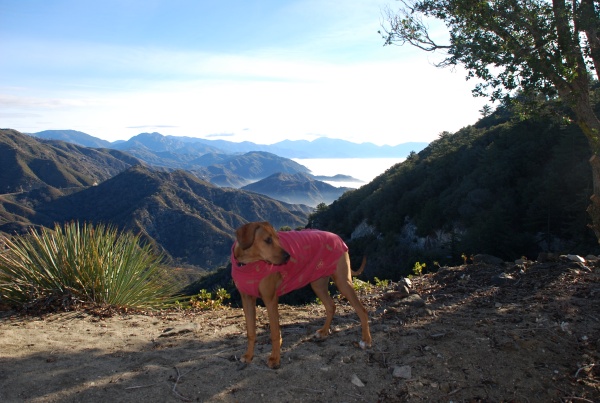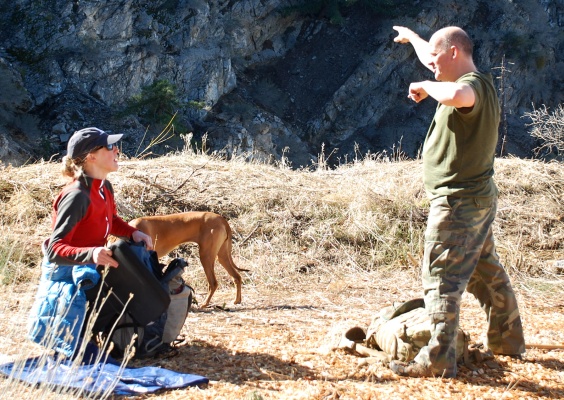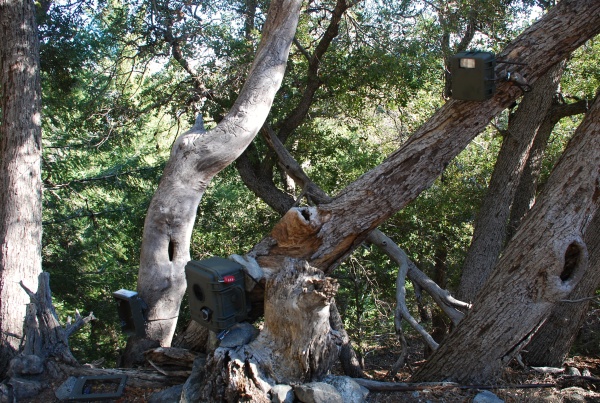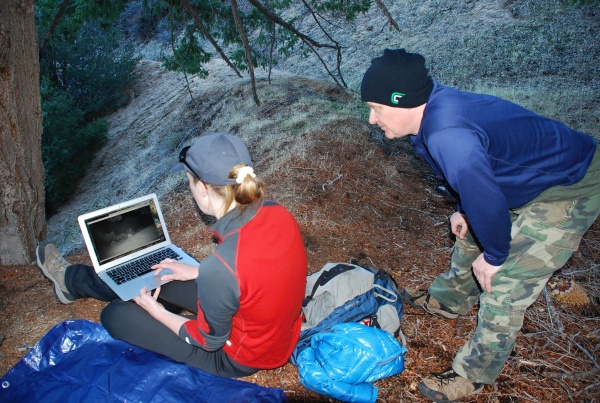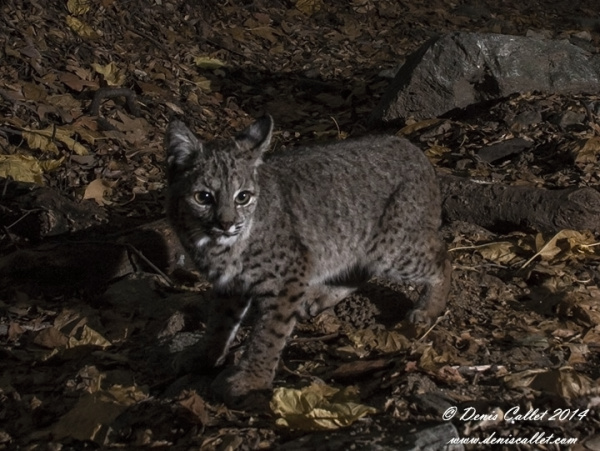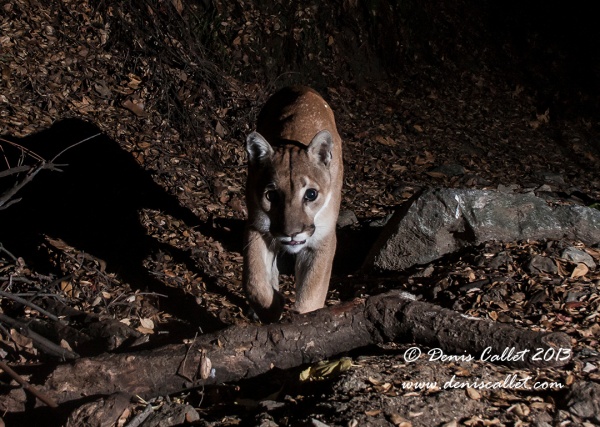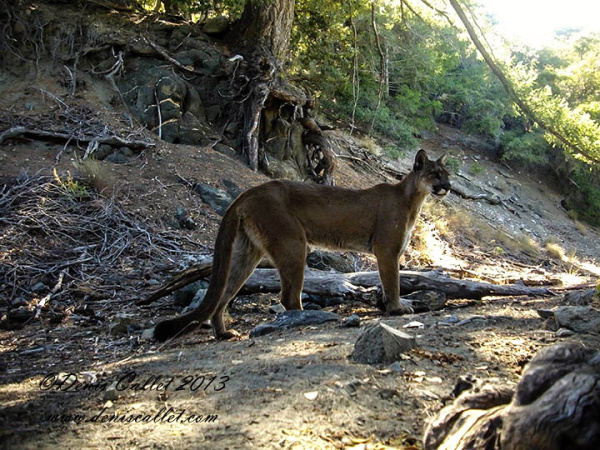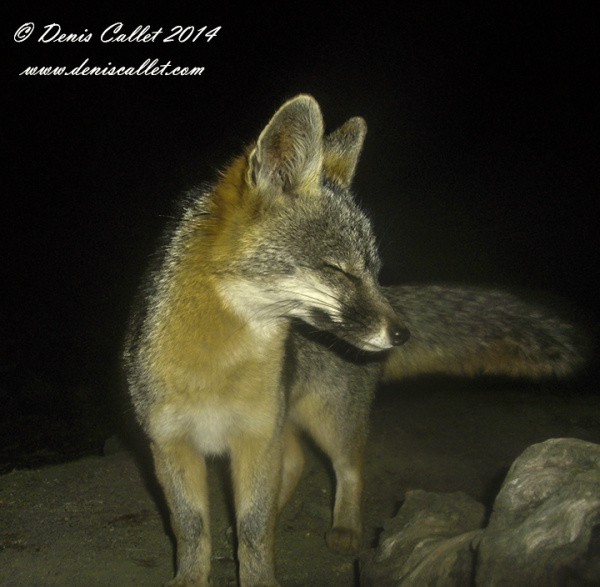Camera Trapping Masters
“Science doesn’t belong only to the people who go to school for it, today, it’s available for everyone to become a citizen scientist,” says Denis Callet, a Montrose-based photographer, as he hikes up a secluded trail in the Los Angeles Forest.
It’s bright and early on a Saturday morning and Callet is joined by fellow outdoor enthusiastic, Johanna Turner who has been recording trail cam images of SoCal mountain lions, bobcats and other local critters since 2007. Turner’s well behaved dog Ripley joins the duo who connected about two years ago through their fierce love of local wildlife.
Callet and Turner wouldn’t have met in their normal 9-5 world; he works retail and she’s in the entertainment business. But together they are slowly transforming the science of the trail camera – now a must for any outdoor research biologist – into a template for art.
Today, the two are hiking to check their four cameras hidden in the forest; they also have cameras in remote local areas. Sure, they have the standard Bushnell cameras that collect video images, but these camera trappers are anxious to see is what Callet’s homemade DSLRs – which yield high quality color images – have clicked in the past two weeks.
Callet and Turner each carry big backpacks full of equipment, hardware, batteries, cords, zip-ties, duct tape and more. Turner also carries her laptop so the two can check on how the cameras are positioned, if the lighting, sensors and triggers are working, etc. etc.
It’s hard to gauge what’s the main topic of conversation on the trail – the refinements they are going to make to the camera and camera set-up or the wildlife that surrounds them.
Big ticket cameras are “not in our budget; we’re not using top of the line stuff,” says Turner about camera trapping that was original marketed toward hunters and landowners. But Callet’s prowess with photographic equipment and his MacGyver-like ability to jerry-rig pieces and parts (“eBay is a very, very, very good thing,” he says) is yielding fantastic results.
“He’s so picky about the images, things that I think are wonderful, but he wants them perfect,” says Turner about Callet’s perfectionistic streak.
These remote animal portraits are difficult to come by. Remember, it took National Geographic photographer Steve Winter a year and a half to get that now famous shot of Griffith’s Parks P-22 with the Hollywood Sign in the background.
“And that cat had a collar so they knew where he goes and his regular paths,” chimes in Callet in his thick French accent. (He came to SoCal 27 years ago.) “Winter also had a team who would go out and check the cameras,” adds Turner. “It’s just us doing this.”
Indeed, Turner has been camera trapping for a long time. On her popular CougarMagic blog, Turner shares images taken with her remote cameras that she’s set up all around SoCal wild areas. These days, she’s posting more frequently on CougarMagic’s Facebook page. Years ago, she posted images of a collar mountain lion – P-12 – in the Santa Monica Mountains that caught the attention of National Park Service ranger Jeff Sikich. That photo revealed a broken radio collar which helped Sikch understand why he was having trouble tracking the big cat.
“Citizen scientists can provide some real important data for us,” he says adding that, “There are not that many people out there doing this. Cameras can get stolen or damaged. It’s hard work. But Johanna has such a passion and is so dedicated to it. She’s been able to cover areas of the mountains that I haven’t been to.”
Equally enthusiastic about wildlife behind a camera, Callet admired Turner’s popular Cougarmagic blog/YouTube Channel for years. He finally sent her an email about collaboration and encouraged her to check out his personal blog of nature photos, many taken in the Hahamonga Watershed Park, the Arroyo Seco and surrounding terrain. Dramatic photos of ospreys, great horned owls and videos of red shoulder hawks feeding their young. “I knew he was for real and serious,” she explains. “He has the eye and passion for this.”
After a 45 minute hike from the parked car, the pair finally reaches the first cameras that are secured tightly in Pelican boxes and fastened with strong ties.
“Look at this…112 videos. That’s a lot!” remarks Calett as Turner takes out her laptop to pop in the SD card. It’s a lot like Christmas as the two scroll through images of squirrels, squirrels and even more squirrels, some cavorting in a recent snow storm. Will it be a disappointment? “It’s never a disappointment when you are out in nature,” says Callet emphatically. “Even when we don’t get anything, we can learn how to set it up better.”
Turner chides him: “I have seen you disappointed! Right when the sensor missed by a second. You get frustrated then.”
“Well…yes, that’s true…” reluctantly admits Callet with a sheepish grin.
Near the end of the SD card, the duo strikes gold. “Yes!” exclaims Turner, fist in the air and emotion leaking from her eye. It’s King Arthur, a big mountain lion that Turner has camera captured in the area over the past three years. She carefully observes the cat’s walk, how he stops to smell the scent (Obsession by Calvin Klein) and then wanders out of view. It’s like seeing an old friend, she explains. Jackpot, three times over.
After replacing batteries, repositioning lights and triggers, the duo checks the other cameras. Once again, squirrels and foxes are racking up valuable photo space (“It’s like the show should be called, ‘Fox and Friends,’” jokes Callet), but an image of two foxes playing in the snow is noteworthy.
Clicking through the SD faster, Turner suddenly stops. It’s images of a mama bear and cub – in one image they are rolling in the snow. “Do you think it’s the little guy from last year?” she wonders. “Mama looks great! Very healthy. Oh, it’s so good to see her.”
All in all, it’s been a good morning camera trapping for Callet and Turner. Over the years, they’ve spent thousands of dollars, countless hours hiking back and forth from remote locations, often coming back only with bad batteries, empty shots and unusable images.
But the times that skill, expertise and luck all clicks together to produce Olympic gold images make up for any frustration or disappointment. Hands down.
“This is more than a hobby, it’s about conservation because these guys need all the help they can get,” says Turner. “Camera trapping is like a religion,” agrees Callet. “You just have to believe.”
– Brenda Rees, Editor
Below are just some of the images that Callet (along with Turner’s help) have produced. We advocate that any sane photographic gallery sign them up for an exhibition…stat!!

